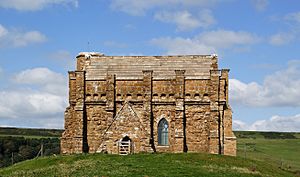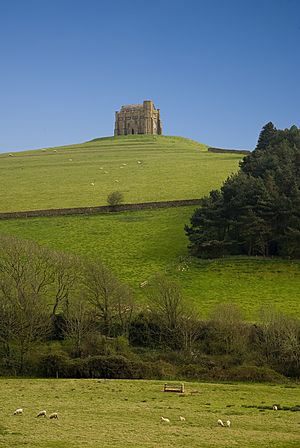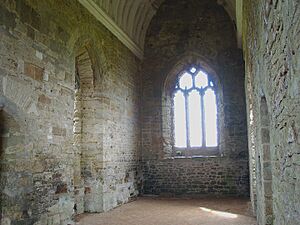St Catherine's Chapel, Abbotsbury facts for kids
Quick facts for kids St Catherine's Chapel |
|
|---|---|

St Catherine's Chapel
|
|
| Location | Abbotsbury in Dorset, England |
| Owner | English Heritage |
| Official name: Chapel of St Catherine | |
| Type | Grade I |
| Designated | 26 January 1956 |
| Reference no. | 1172576 |
| Official name: St Catherine's Chapel, field system and quarries at Chapel Hill | |
| Designated | 19 December 1958 |
| Reference no. | 1015694 |
| Lua error in Module:Location_map at line 420: attempt to index field 'wikibase' (a nil value). | |
St Catherine's Chapel is a small, ancient chapel located on a hill high above the village of Abbotsbury in Dorset, England. It is dedicated to Saint Catherine, a very important saint. This special building is now looked after by English Heritage. It became a Grade I listed building in 1956, which means it's a very important historic site. The chapel, along with old field systems and quarries on the hill, is also a scheduled monument. This protects it even more.
You can get the best view of the chapel from the B3157 road between Abbotsbury and Bridport. From there, you can see the famous Chesil Beach in the background. The old terraced fields on the hillside are known locally as the Chapel Rings.
History of St Catherine's Chapel
Even though we don't have exact records of when it was built, experts believe St Catherine's Chapel was constructed in the late 14th century. This was around the same time as the large tithe barn in Abbotsbury. The chapel stands on a raised area, which might have been used for a pagan temple long ago.
The monks from the nearby Benedictine monastery, Abbotsbury Abbey, built St Catherine's Chapel. It was a quiet place for them to go on pilgrimages and to pray alone. The chapel sits high on a hilltop, about 80 meters (260 feet) above the coast. From here, it overlooks the sea from Portland Bill to Bridport. This made it a very important landmark for sailors. Not many chapels like this were built outside monastery grounds. Its isolated spot allowed the monks to leave the main abbey during Lent for private prayer and quiet thinking.
In the 16th century, many monasteries were closed down during the dissolution of the monasteries. The main buildings of Abbotsbury Abbey were destroyed. However, St Catherine's Chapel survived. This was probably because it was so useful as a beacon and landmark for ships along the coast. In later years, a navigation light was even lit at the top of its stair turret. The chapel was repaired in 1742 and again in the late 1800s, but it still looks much like it did hundreds of years ago.
Today, English Heritage cares for the chapel. It is open to visitors during the busiest times of the year, and entry is free. The local church in Abbotsbury also holds several informal services at St Catherine's Chapel each year, usually from June to December.
Chapel Design and Structure
St Catherine's Chapel is a rectangular building made entirely from local golden-colored ashlar limestone. It was built to be incredibly strong to stand up to the weather. Its walls are about 4 feet thick and are supported by sturdy buttresses. Even the roof and the ceiling inside are made of stone! This design allows rainwater to drain off the roof through special holes in the wall between the buttresses.
In the northwest corner of the chapel, there is a tower. In the northeast corner, a stair turret (a small tower with stairs inside) rises above the roof. This turret is octagonal (eight-sided) on the outside and lets people get onto the roof's edge. There is also a tiny prayer room, called an oratory, at roof level. The buttresses and the stair turret probably had decorative pointed tops, called pinnacles, when they were first built. The stone slab roof was replaced in 1983 with Clipsham stone.
The chapel looks much larger than it actually is. Its tall walls and high parapets (the low protective walls along the roof edge) were designed to look grand. This feeling of importance is made even stronger by the chapel's high position on the hill. Inside the chapel, in medieval times, there would have been colorful stained glass windows. The details of the roof would have been painted in bright colors. At the points where the arched ceiling meets, you can see carved stone decorations called bosses. These carvings show plants, people, and animals. The chapel's main window is a large triple window on the east wall, but there are smaller windows on the other walls too.
Traditions of St Catherine
Saint Catherine is known as a special saint for young women who wished for a partner. Until the late 1800s, there was a local tradition at the chapel. Young women from Abbotsbury would come to "wish." They would use special niches (small hollows) in the east side of the south doorway. One niche was for a knee, and two other holes were for their hands. They would use these spots to "post" their prayers and make a wish to Saint Catherine, asking for her help.
A traditional prayer used here goes like this:
A husband, St Catherine,
A handsome one, St Catherine,
A rich one, St Catherine,
A nice one, St Catherine,
And soon, St Catherine.
In the local dialect, the request would end with "Arn-a-one's better than Narn-a-one." This means that having any partner is better than having none at all.
It's quite rare to find a chapel dedicated to St Catherine of Alexandria, but her story was very popular in medieval England. When early Christian missionaries came to England around 600 AD, they often tried to build Christian churches and chapels on the sites of old pagan temples. They would choose a Christian saint who was similar to the old pagan god or goddess. This chapel is likely an example of that. Chapels dedicated to St Catherine are often found on hills, possibly because her story is linked to Mount Sinai.




